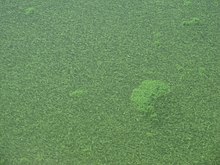Aphanizomenon
| Aphanizomenon | |
|---|---|

| |
| Aphanizomenon flos-aquae | |
| Scientific classification | |
| Domain: | Bacteria |
| Phylum: | Cyanobacteria |
| Class: | Cyanophyceae |
| Order: | Nostocales |
| Family: | Aphanizomenonaceae |
| Genus: | Aphanizomenon A.Morren ex Bornet & Flahault, 1888 |
| Species | |
|
Aphanizomenon flos-aquae Aphanizomenon gracile Aphanizomenon issatschenkoi Aphanizomenon ovalisporum | |
Aphanizomenon is a genus of
Ecology
Overcoming phosphate limitation
Aphanizomenon may become dominant in a water body partially due to their ability to induce phosphate-limitation in other phytoplankton while also increasing phosphate availability to itself through release of cylindrospermopsin.[4] The cylindrospermopsin causes other phytoplankton to increase their alkaline phosphatase activity, increasing inorganic phosphate availability in the water to Aphanizomenon during times when phosphate becomes limiting.
Photosynthesis
All species in the cyanobacteria phylum can perform photosynthesis. They use a similar photosynthesis to plants, using two photosystems which is called the
Nitrogen fixation
Aphanizomenon are a special type of cyanobacteria called heterocysts, which are capable of producing biologically useful nitrogen (ammonium) by the process of nitrogen fixation from atmospheric nitrogen.
A large proportion (between 35 and 50%) of fixed nitrogen may be released into the surrounding water, providing an important source of biologically available nitrogen to the ecosystem.[6][7] Since Aphanizomenon are one of the few species of bacteria that can perform nitrogen fixation, other bacterial species that use nitrogen ions as a reactant will start to rely on the species as a source of usable nitrogen. This will cause a bacterial bloom to form, which is a condition under which the number of bacterial colonies in an area will suddenly increase.[8]
Algal blooms
Aphanizomenon can produce algal blooms from producing usable nitrogen causing other bacterial species to form colonies around the Aphanizomenon. Algal Blooms formed from Aphanizomenon species tend to be very toxic and create a variety of toxins. These blooms may also create dead zones in the water. This ends up being bad for the ecosystem, since it can hurt many of the plants and animals living around it.[9]
Toxin production
Aphanizomenon species may produce
Colony formation

Aphanizomenon may form large colonies as a defense against herbivore grazing, especially Daphnia in freshwater. [14]
See also
References
- ^ "Phycokey - Aphanizomenon". cfb.unh.edu. Retrieved 2021-04-22.
- ^ "Life History and Ecology of Cyanobacteria". ucmp.berkeley.edu. Retrieved 2021-04-27.
- ^ Konopka, A.; T. D. Brock; A. E. Walsby (1978). "Buoyancy regulation by planktonic blue-green algae in Lake Mendota, Wisconsin". Arch. Hydrobiol. 83: 524–537.
- PMID 20705465.
- PMID 24478787.
- PMID 26262817.
- PMID 20428225.
- ^ "Bacterial Bloom, Cloudy Water, Ammonia/Nitrite Spike - What do I do?". the fishroom. 2019-12-09. Retrieved 2021-04-27.
- ^ US EPA, OW (2013-06-03). "Harmful Algal Blooms". US EPA. Retrieved 2021-05-10.
- US EPA. 2015. Archived from the originalon 2015-10-17. Retrieved 2015-10-25.
- ^ "Aphanizomenon (cyanoScope) · iNaturalist". iNaturalist. Retrieved 2021-04-27.
- ^ Minnesota Department of Health. "Anatoxin-a and Drinking Water" (PDF). Archived (PDF) from the original on 2020-10-20. Retrieved 2021-05-07.
- ^ "Saxitoxin - an overview | ScienceDirect Topics". www.sciencedirect.com. Retrieved 2021-05-08.
- ^ "Aphanizomenon blooms: alternate control and cultivation by Daphnia pulex" (PDF). American Society of Limnology and Oceanography Special Symposium No. 3: 299-304. 1980.
Guiry, M.D.; Guiry, G.M. "Aphanizomenon". AlgaeBase. World-wide electronic publication, National University of Ireland, Galway.
